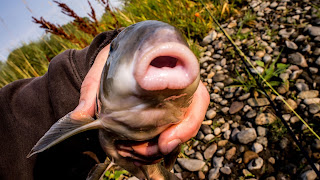Having an extremely nice rod for only three weeks, I was momentarily tempted to live amongst the Kaczynskis long-beard-style in the mountains, existing on the trout that my new Sage Circa earns me. Alas that daydream passed, but not so for the pleasure of casting the Circa.
To preface this review: I am a simple man who knows not the fancy lingo and mechanics of fly casting. Shiny reels and expensive rods frighten me. But I can tell you that once I slowed my stroke and shot line, it was an absolute joy to use the super-slow Circa.
I tend to cast fiberglass rods further than graphite, and the graphite Circa was very similar for me. It's smooth and satisfying; super light (2.5 ounces) and thin, lays dries down softly and punches nymphs and streamers with ease. This 8-foot 9-inch 5-weight would make a perfect all-around trout-fishing rod. If you've never cast fiberglass, the Circa will give you an idea. If you have, you might not go back.
My first impression - it was hard to get used to on small, overgrown water (not that this size rod was intended for small overgrown water). Where casting is difficult, I want to cast fast. It's more suitable for medium to big water - this particular Circa.
Fighting fish with it is a hoot, especially decent-sized or otherwise feisty ones. The faux-fiberglass bobs and bends like no graphite I've encountered. It'd double-over without straining, and gave me plenty of leverage against the fish. It's ultra-light so end-of-day arm fatigue and shoulder soreness should be minimized.
I own two old, heavy, fiberglass rods (St. Croix and Wright & McGill - both 7-8 weights) and recently cast a couple modern 'glass rods (a Lamiglas 7-foot 3-weight and a Steffen Brothers 8-foot 4-5-weight). The newer rods were pleasant and fun ('glass has come a long way), but if you're a fan of Sage, I wouldn't recommend anything else.
I would consider over-lining it with 5.5- or 6-weight line as I suspect there's a chance it loads a touch more noticeably. But it casts fine with appropriate line, too.
 |
The deep, sexy bend in the fiberglass Circa in the foreground
compared to the graphite VXP in the background. |
Now I'm again thinking about running into the mountains before I have to return it...
UPDATE: I have since purchased my own Circa, and I still love the way it casts. But I am finding Sage rods to be a bit fragile. I now have to send a rod in for repair for the second time this year. The $70 repair fees add up (especially when the service is covered under warranty), and the six weeks without the rod sucks. And waiting 24 to 48 hours to hear back from customer service also sucks. With that in mind, buy Sage rods at your own risk. I'm going to look at Winston for my next go-to rod.
Sage Click Reel: At first I was confused by the drag. It's
very light, and apparently adjustable, but too subtle for this simple angler to notice. It is a click drag system which is designed to only give enough tension to disallow free-spooling of the reel. You make your own drag with your palm, or whatever. Some may like that idea, others not, but it keeps things a little more affordable and adds an element to fishing. I know steelheaders who've used click drag reels, so it must be manageable for trout.
For my taste and others who cast my setup, the drag was just too light. It would let line off when casting heavy flies and would spool a little when manually pulling line off. I get the concept, but I prefer a little more tension than that offered by the Click.
Rio Perception Line: I like that it has loops on both ends so I don't have to enforce any seldom-used knots that add to the overall circumference of my spool. It was a nice, easily-castable high-floating line. It didn't crack or sink within three weeks.
It also has the front and rear tapers of the head and the running line broken down into different colors, providing quick info for a number of different casting and fishing applications.
Rio is promoting the line as: "Built with ultra-low stretch ConnectCore Technology, the RIO Perception lines provide pioneering levels of sensitivity for intuitively better cast timing, easier line lift and sharp, precise mends. Lack of stretch also means enhanced detection of subtle takes and significantly reduced reaction time when setting the hook." It would be hard for me to distinguish what difference the line made when casting and fishing a fancy new rod, but it certainly didn't hurt. Either way, this line on this rod makes a winning combination.

















